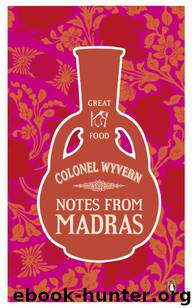Notes from Madras by Arthur Robert Kenney-Herbert 'Wyvern'

Author:Arthur Robert Kenney-Herbert 'Wyvern' ['Wyvern', Arthur Robert Kenney-Herbert]
Language: eng
Format: epub, azw3, mobi
ISBN: 9780141965918
Publisher: Penguin Books Ltd
Published: 2011-04-07T04:30:00+00:00
On Coffee-Making
On certain occasions in the course of my jottings, I have mentioned the cup of café noir as the finishing touch of a nice little dinner. I think, therefore, that I may as well say a few words regarding its composition before I ask you to consider my menus ended.
Although few may think themselves ignorant of coffee-making, I question whether its real secrets are generally known. Indeed to judge by the stuff that we usually get, I think, we may say that the art is comparatively rare. First, to be sure, you must ‘catch your coffee,’ i.e.: – get really good berries, and be willing to pay a trifle over the usual price for them. That done, the next thing to learn is the roasting, an operation that should be conducted daily if you want well-flavoured coffee. The process is by no means as easy as many believe; half the coffee we drink is ruined by ignorant roasting; a burnt berry, mark you, will spoil the whole brew. The best way, I think, to roast the berries is to do a few at a time in a frying-pan over a very low fire, passing them straight to the mill (a hand-mill is quite indispensable) from the pan. A table-spoonful of berries will be found quite enough at a time. Melt a little butter, sufficient to lubricate the berries, and stir them about until they turn a light Havannah brown; if perchance a berry take a darker tint, throw it away as you would a reptile; grind them at once as coarsely as your mill will admit, – the grains should be quite as large as those of rifle gun-powder, – and make the coffee as soon afterwards as possible.
A little butter or salad oil is strongly recommended, it prevents the escape of much of the fragrance of the berry while roasting, and becomes quite dried up before the roasting is finished. The custom in the Indian kitchen is to bake, often to over-bake, the berries and then tunnycutch ammah pounds them to a dull black powder as fine as flour. The result is a leaden tinted liquid, acrid in flavour, and repulsive to look upon.
Having ground the coffee properly, – it should be rich in aroma, and of a beautiful pale snuff colour – the best coffee-pot to use, after all, is the percolator. Be liberal with the coffee (a table-spoonful for each person), heat the coffee-pot thoroughly, fill the upper chamber of the percolator according to your requirements, ram the coffee down firmly, and having previously measured the amount of coffee liquid you require, pour boiling water, according to that measurement, in tea-spoonfuls at a time, through the upper strainer upon the powder. The slower the water is added, the more thoroughly the coffee will become soaked, and, the dripping being retarded, the essence will be as strong as possible. As soon as the coffee has run through, pour the rich essence you have obtained into your cups, and for café au lait fill them up with boiling milk, for café noir with a little boiling water.
Download
Notes from Madras by Arthur Robert Kenney-Herbert 'Wyvern'.azw3
Notes from Madras by Arthur Robert Kenney-Herbert 'Wyvern'.mobi
This site does not store any files on its server. We only index and link to content provided by other sites. Please contact the content providers to delete copyright contents if any and email us, we'll remove relevant links or contents immediately.
DK Eyewitness Travel Guide Japan by DK Travel(1247)
Wanting by Sarah Masters(1223)
The Collagen Diet by Dr. Josh Axe(1189)
Le camp by Unknown(1131)
The Safe Word by Karen Long(1035)
Sushi for Beginners by Marian Keyes(947)
Ruby Ridge(941)
100 Techniques by Unknown(940)
The Biml Book by unknow(924)
Ninja by Unknown(894)
Maangchi's Big Book of Korean Cooking by Maangchi(878)
Eating Animals by Unknown(847)
Heritage Cuisines by Unknown(812)
Beautiful Fighting Girl by unknow(812)
Global Health Watch 4 by Global Health Watch(810)
Blood Lines 04 by Blood Price(796)
Authentic by Stephen Joseph(794)
The American West by unknow(774)
Perfect_Questions_Perfect_Answers by unknow(753)
